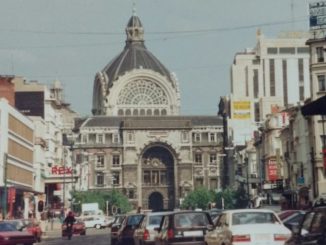It’s difficult to tell exactly where we are in old Zermatt, pictured below during my grandparent’s 1950s road trip. These days the town is short of public squares given what has to be squeezed onto limited flat land next to the Matter Vispa river as she carves her way north from the Matterhorn to Visp through Switzerland’s deepest valley.
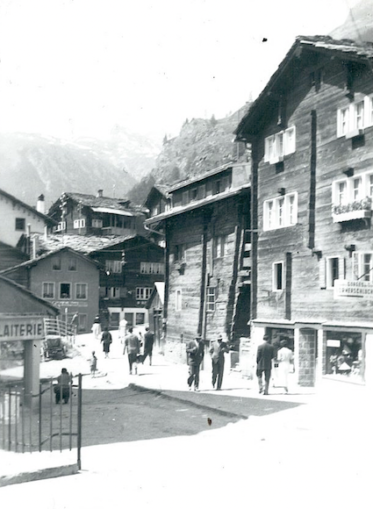
© Always Worth Saying 2023, Going Postal
The photograph could have been taken along Bahnhofstrasse which runs from the railway station to the parish church of St Mauritius. Via the miracle of Street View, the hills in the background should be a help but the area is now so built up they can’t be seen. In the old photo, ground level already consists of touristy shops. Near vertical ship’s-type ladders lead to wooden chalet’s upper stories. Even today some buildings are on wooden pegs resting on stone or concrete foundations.
Apart from ‘Laiterie’, meaning dairy, signage is difficult to make out. Is there a shopkeeper called Gorges? Or does it read ‘Gornergrat’, a popular name hereabouts due to the nearby Gornergrat Ridge that sits at the end of a rack and pinion railway climb? Perhaps a more proficient German-speaking Puffin than I can make sense of lettering which appears to read ‘Gopwerschlbcht’.
Walking away from the railway station towards the church it is still possible to capture the old Zermatt. It would be nice to say I’d found the exact same spot below but even if I had it will have changed in the intermediate seven decades with its attendant addition of seven million tons of concrete.

© Google Street View 2023, Google
Outside wooden steps are still there. Did the faded sign once read ‘Gopwerschlbcht’? Who’s to say it didn’t? Sure enough, further up the same street, the chalets are on big wooden pegs on top of a lower concrete story. You can look around the area for yourself via this link.
Last time, in the snow and close to the present day, we ascended the mountains behind Zermatt via the Gornergrat cog railway. This week and seven decades previous, we leave from Zermatt town centre and ascend the mountainside by a two-chair lift which rises to Sunnegga. The Sunnegga area was opened up in 1942 with the installation of a ski and walking lift which was replaced in 1946 by a chair lift. The following February, ‘Jennifer’ and her Social Journal were in the locale on behalf of The Tatler.
Tatler’s finest drove up the main street in a jingling horse-drawn sleigh with the giant Matterhorn on the skyline ahead. The main street was surprisingly narrow and bordered with picturesque brown wood chalets, small inn parlours and gay little shops displaying the brightest Swiss merchandise. Skating and curling rinks were dotted about the village among the chalets but it was for the skiing that Jennifer found most people were there for. After noting the cog railway to Gornergrat, Jenifer nodded towards the newly built two-seat chair lift to Sunnegga.
“From there the ski-lift transports you to the lovely ski fields of Blauherd 2,600 ft above Zermatt where you can start downhill runs to Tufternalp, Brunnenbord, Syunnegga and Findeln.”
However, Jennifer spoilt her copybook by doing Gornergrat rather than Sunnegga and spending the rest of the article dropping names. Behind the dark glasses or goggles, worn as a necessity because of the brilliant sunshine, and within the white, scarlet or pale blue jackets worn by man and woman alike, lurked the likes of Captain S Howard-Stepney, Baroness Anne de Graevenitz, Lord Shelburne’s son and Lt-Col Kenneth Norton-Evans. Not to mention Mr Bill Broken, the only man to hold the coveted A.K. medal, Mrs Cafferatta, out for a couple of weeks from Nottinghamshire and a Mrs Fairclough who had a chalet in Zermatt where she left her three young children while on the piste.
Meanwhile, my grandparents took the artisans’ summer route on the chair lift to Sunnegga. At the top are panoramic views of, left to right while facing back to Zermatt; the Matterhorn, Obergabelhorn, Wellenkuppe, Zinalrothorn and Weisshorn, as located on the map below.

© Google Street View 2023, Google
By the 1970s there was a problem with the capacity of the chairlift and the bottlenecks that resulted. It was decided to replace it with a funicular railway tunnelled through the mountainside. What is a funicular railway? According to wiki:
A funicular is a type of cable railway system that connects points along a railway track laid on a steep slope. The system is characterized by two counterbalanced carriages (also called cars or trains) permanently attached to opposite ends of a haulage cable, which is looped over a pulley at the upper end of the track. The result of such a configuration is that the two carriages move synchronously: as one ascends, the other descends at an equal speed.
The Zermatt-Sunnegga Funicular or the Standseilbahn Zermatt–Sunnegga, known as the SuneggaExpress for short, consists of a single 1-metre gauge line, two cars and a passing loop. The gradient is so steep, one in two, that the cars and platforms are stepped rather than flat. The track is 5,000ft long and it takes three minutes to ascend the 2,290 ft from Zermatt to Sunnegga. Each car can carry 200 passengers. Opened in November 1980, within 15 months of operation it had already carried one million passengers.
The view from the top of the funicular can be taken in via this link.
Making a comparison to the old album photographs suggests the chairlift also terminated thereabouts. With reference to the old photos we shall take in the panorama of the mountains opposite. I’m grateful to Zermatt.ch whose descriptions I have summarised.
The Matterhorn
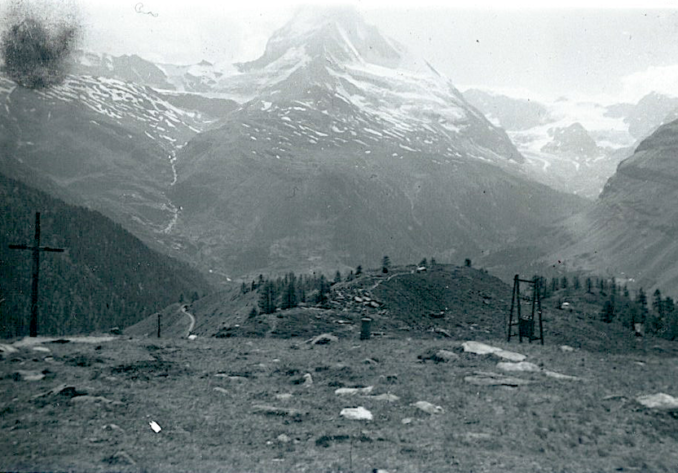
© Always Worth Saying 2023, Going Postal
The Matterhorn needs no introduction and has been covered in recent previous episodes of our album tour.
Obergabelhorn and Wellenkuppe

© Always Worth Saying 2023, Going Postal
To the left we can see the Obergabelhorn, at 13,330ft considered to be one of the nicest mountains of Zermatt’s Valais canton. The actual summit is way to the left and somewhat above the top of the photograph. There is no easy way to the summit with the easiest but longest being from the Rothornhut. Very steep flanks lie to each side. A smooth ice face to the north is very impressive whereas the south face is of pure rock. From the top, there is a wonderful view of the north face of the Matterhorn.
To the right of Obergabelhorn sits the Wellenkuppe with the Triftbach flowing between them. Described as an easy mountain, only about two and a half hours from the Rothornhutte, Wellenkuppe is 12,805ft high.
Zinalrothorn and the Weisshorn
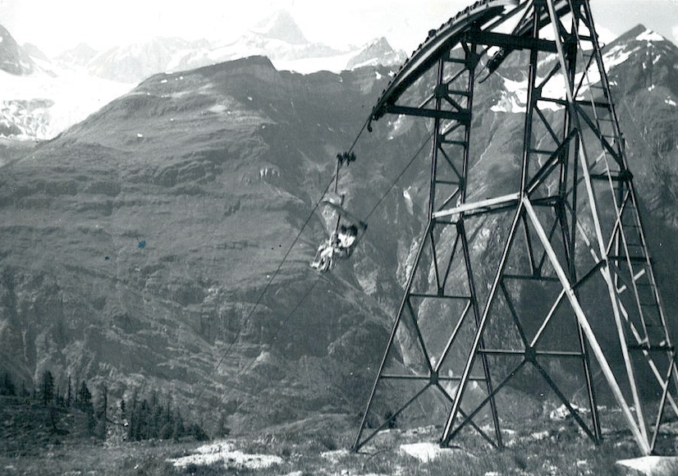
© Always Worth Saying 2023, Going Postal
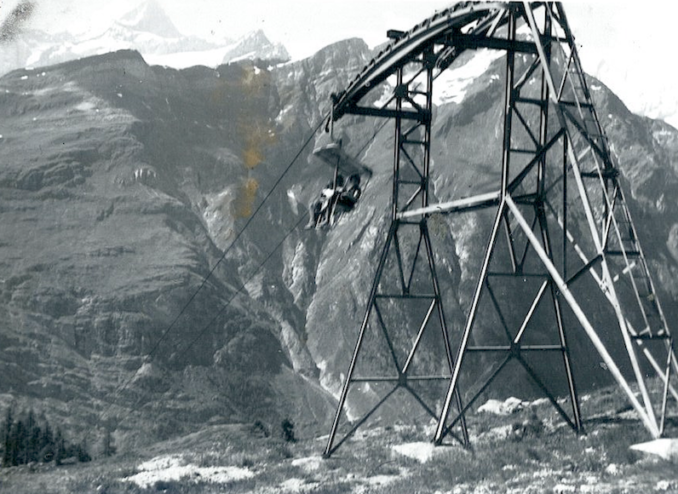
© Always Worth Saying 2023, Going Postal
The Zinalrothorn is to the left, to the very top and is covered in snow. It appears unmistakable because of a lean to one side. The ascent via the Rothornggart ridge is said to be one of the finest rock climbs in the Zermatt region. At 13,848 ft, the first ascent was on 22nd August 1864 and was completed by Florence Crawford Grove, Melchior Anderegg, Leslie Stephen and Jakob Anderegg. We can also observe the original 1946 chairlift which is definitely not for the faint-hearted!
The Weisshorn
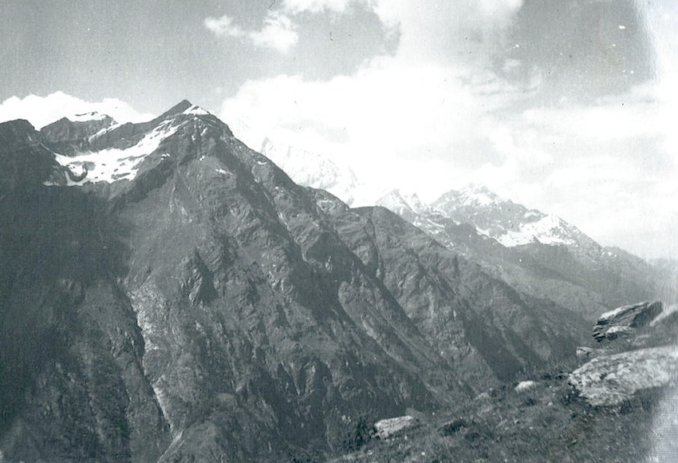
© Always Worth Saying 2023, Going Postal
To the far right and off our map sits the Weisshorn – an impressive 14,780ft in height. A difficult and long climb, even for seasoned mountaineers this is a two-day ascent requiring a guide. Advice to walkers is not to bother but to go to Sunnegga and take photos. Well up the valley, Weisshorn is really at Tasche rather than Zermatt.
Previously unconquered, it was on September 7th 1861 that the Illustrated London News carried a letter from a Professor Tyndall to a friend in England in which he declared he had just gained the summit of this noble alpine mountain. The letter was written from the Monte Rosa Hotel in Zermatt and was dated August 21st 1861. The other members of the professor’s groundbreaking party were Johann Joseph Benet and Ulrich Wenger.
On that triumphant note, we end my grandparents’ 1957 road trip to Switzerland and with it have completed the final page of the family album. I hope you have enjoyed the trips as much as I have. I must confess, the album has sat neglected for years and it wasn’t until embarking upon this series (on account of a few old motorbike pictures near the front) that I actually looked carefully at the images and began to realise their significance.
Hold on. What’s this? Some pages at the back are stuck together. One moment. My word!
To be continued…
© Always Worth Saying 2023


